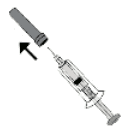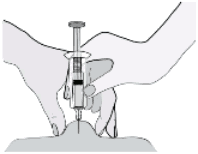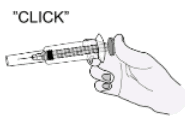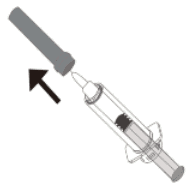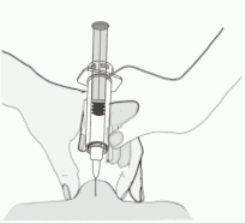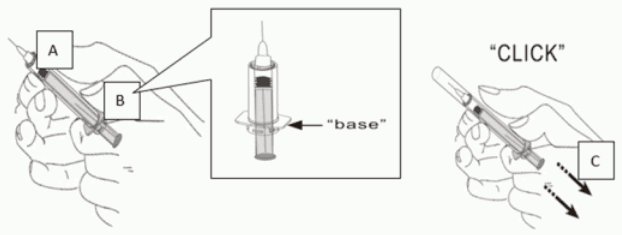INHIXA 2,000 IU Solution for injection in pre-filled syringe Ref.[27648] Active ingredients: Enoxaparin
Source: Medicines & Healthcare Products Regulatory Agency (GB) Revision Year: 2020 Publisher: Techdow Pharma Netherlands B.V., Strawinskylaan 1143, Toren C-11, 1077XX Amsterdam, Netherlands
4.1. Therapeutic indications
Inhixa is indicated in adults for:
- Prophylaxis of venous thromboembolic disease in moderate and high risk surgical patients, in particular those undergoing orthopaedic or general surgery including cancer surgery.
- Prophylaxis of venous thromboembolic disease in medical patients with an acute illness (such as acute heart failure, respiratory insufficiency, severe infections or rheumatic diseases) and reduced mobility at increased risk of venous thromboembolism.
- Treatment of deep vein thrombosis (DVT) and pulmonary embolism (PE), excluding PE likely to require thrombolytic therapy or surgery.
- Prevention of thrombus formation in extra corporeal circulation during haemodialysis.
- Acute coronary syndrome:
- Treatment of unstable angina and Non ST-segment elevation myocardial infarction (NSTEMI), in combination with oral acetylsalicylic acid.
- Treatment of acute ST-segment elevation myocardial infarction (STEMI) including patients to be managed medically or with subsequent percutaneous coronary intervention (PCI).
4.2. Posology and method of administration
Posology
Prophylaxis of venous thromboembolic disease in moderate and high risk surgical patients
Individual thromboembolic risk for patients can be estimated using validated risk stratification model.
- In patients at moderate risk of thromboembolism, the recommended dose of enoxaparin sodium is 2,000 IU (20 mg) once daily by subcutaneous (SC) injection. Preoperative initiation (2 hours before surgery) of enoxaparin sodium 2,000 IU (20 mg) was proven effective and safe in moderate risk surgery.
In moderate risk patients, enoxaparin sodium treatment should be maintained for a minimal period of 7-10 days whatever the recovery status (e.g. mobility).Prophylaxis should be continued until the patient no longer has significantly reduced mobility.
- In patients at high risk of thromboembolism, the recommended dose of enoxaparin sodium is 4,000 IU (40 mg) once daily given by SC injection preferably started 12 hours before surgery. If there is a need for earlier than 12 hours enoxaparin sodium preoperative prophylactic initiation (e.g. high risk patient waiting for a deferred orthopaedic surgery), the last injection should be administered no later than 12 hours prior to surgery and resumed 12 hours after surgery.
- For patients who undergo major orthopaedic surgery an extended thromboprophylaxis up to 5 weeks is recommended.
- For patients with a high venous thromboembolism (VTE) risk who undergo abdominal or pelvic surgery for cancer an extended thromboprophylaxis up to 4 weeks is recommended.
Prophylaxis of venous thromboembolism in medical patients
The recommended dose of enoxaparin sodium is 4,000 IU (40 mg) once daily by SC injection.
Treatment with enoxaparin sodium is prescribed for at least 6 to 14 days whatever the recovery status (e.g. mobility). The benefit is not established for a treatment longer than 14 days.
Treatment of DVT and PE
Enoxaparin sodium can be administered SC either as a once daily injection of 150 IU/kg (1.5 mg/kg) or as twice daily injections of 100 IU/kg (1 mg/kg).
The regimen should be selected by the physician based on an individual assessment including evaluation of the thromboembolic risk and of the risk of bleeding. The dose regimen of 150 IU/kg (1.5 mg/kg) administered once daily should be used in uncomplicated patients with low risk of VTE recurrence. The dose regimen of 100 IU/kg (1 mg/kg) administered twice daily should be used in all other patients such as those with obesity, with symptomatic PE, cancer, recurrent VTE or proximal (vena iliaca) thrombosis.
Enoxaparin sodium treatment is prescribed for an average period of 10 days. Oral anticoagulant therapy should be initiated when appropriate (see “Switch between enoxaparin sodium and oral anticoagulants” at the end of section 4.2).
Prevention of thrombus formation during haemodialysis
The recommended dose is 100 IU/kg (1 mg/kg) of enoxaparin sodium.
For patients with a high risk of haemorrhage, the dose should be reduced to 50 IU/kg (0.5 mg/kg) for double vascular access or 75 IU/kg (0.75 mg/kg) for single vascular access.
During haemodialysis, enoxaparin sodium should be introduced into the arterial line of the circuit at the beginning of the dialysis session. The effect of this dose is usually sufficient for a 4-hour session; however, if fibrin rings are found, for example after a longer than normal session, a further dose of 50 IU to 100 IU/kg (0.5 to 1 mg/kg) may be given.
No data are available in patients using enoxaparin sodium for prophylaxis or treatment and during haemodialysis sessions.
Acute coronary syndrome: treatment of unstable angina and NSTEMI and treatment of acute STEMI
- For treatment of unstable angina and NSTEMI, the recommended dose of enoxaparin sodium is 100 IU/kg (1 mg/kg) every 12 hours by SC injection administered in combination with antiplatelet therapy. Treatment should be maintained for a minimum of 2 days and continued until clinical stabilization. The usual duration of treatment is 2 to 8 days.
Acetylsalicylic acid is recommended for all patients without contraindications at an initial oral loading dose of 150–300 mg (in acetylsalicylic acid-naive patients) and a maintenance dose of 75–325 mg/day long-term regardless of treatment strategy.
- For treatment of acute STEMI, the recommended dose of enoxaparin sodium is a single intravenous (IV) bolus of 3,000 IU (30 mg) plus a 100 IU/kg (1 mg/kg) SC dose followed by 100 IU/kg (1 mg/kg) administered SC every 12 hours (maximum 10,000 IU (100 mg) for each of the first two SC doses). Appropriate antiplatelet therapy such as oral acetylsalicylic acid (75 mg to 325 mg once daily) should be administered concomitantly unless contraindicated. The recommended duration of treatment is 8 days or until hospital discharge, whichever comes first. When administered in conjunction with a thrombolytic (fibrin specific or non-fibrin specific), enoxaparin sodium should be given between 15 minutes before and 30 minutes after the start of fibrinolytic therapy.
- For dosage in patients ≥ 75 years of age, see paragraph “Elderly”.
- For patients managed with PCI, if the last dose of enoxaparin sodium SC was given less than 8 hours before balloon inflation, no additional dosing is needed. If the last SC administration was given more than 8 hours before balloon inflation, an IV bolus of 30 IU/kg (0.3 mg/kg) enoxaparin sodium should be administered.
Paediatric population
The safety and efficacy of enoxaparin sodium in paediatric population have not been established.
Elderly
For all indications except STEMI, no dose reduction is necessary in the elderly patients, unless kidney function is impaired (see below “renal impairment” and section 4.4).
For treatment of acute STEMI in elderly patients ≥75 years of age, an initial IV bolus must not be used. Initiate dosing with 75 IU/kg (0.75 mg/kg) SC every 12 hours (maximum 7,500 IU (75 mg) for each of the first two SC doses only, followed by 75 IU/kg (0.75 mg/kg) SC dosing for the remaining doses). For dosage in elderly patients with impaired kidney function, see below “renal impairment” and section 4.4.
Hepatic impairment
Limited data are available in patients with hepatic impairment (see sections 5.1 and 5.2) and caution should be used in these patients (see section 4.4).
Renal impairment (see sections 4.4 and 5.2)
Severe renal impairment
Enoxaparin sodium is not recommended for patients with end stage renal disease (creatinine clearance <15 mL/min) due to lack of data in this population outside the prevention of thrombus formation in extra corporeal circulation during haemodialysis.
Dosage table for patients with severe renal impairment (creatinine clearance [15-30] mL/min):
| Indication | Dosing regimen |
|---|---|
| Prophylaxis of venous thromboembolic disease | 2,000 IU (20 mg) SC once daily |
| Treatment of DVT and PE | 100 IU/kg (1 mg/kg) body weight SC once daily |
| Treatment of unstable angina and NSTEMI | 100 IU/kg (1 mg/kg) body weight SC once daily |
| Treatment of acute STEMI (patients under 75) Treatment of acute STEMI (patients over 75) | 1 × 3,000 IU (30 mg) IV bolus plus 100 IU/kg (1 mg/kg) body weight SC and then 100 IU/kg (1 mg/kg) body weight SC every 24 hours No IV initial bolus, 100 IU/kg (1 mg/kg) body weight SC and then 100 IU/kg (1 mg/kg) body weight SC every 24 hours |
The recommended dosage adjustments do not apply to the haemodialysis indication.
Moderate and mild renal impairment
Although no dose adjustment is recommended in patients with moderate (creatinine clearance 30-50 mL/min) and mild (creatinine clearance 50-80 mL/min) renal impairment, careful clinical monitoring is advised.
Method of administration
Inhixa should not be administered by the intramuscular route.
For the prophylaxis of venous thrombo-embolic disease following surgery, treatment of DVT and PE, treatment of unstable angina and NSTEMI, enoxaparin sodium should be administered by SC injection.
- For acute STEMI, treatment is to be initiated with a single IV bolus injection immediately followed by a SC injection.
- For the prevention of thrombus formation in the extra corporeal circulation during haemodialysis, it is administered through the arterial line of a dialysis circuit.
The pre-filled disposable syringe is ready for immediate use.
The use of a tuberculin syringe or equivalent is recommended when using ampoules or multiple-dose vials to assure withdrawal of the appropriate volume of drug.
SC injection technique:
Injection should be made preferably when the patient is lying down. Enoxaparin sodium is administered by deep SC injection.
Do not expel the air bubble from the syringe before the injection to avoid the loss of drug when using pre-filled syringes. When the quantity of drug to be injected requires to be adjusted based on the patient’s body weight, use the graduated pre-filled syringes to reach the required volume by discarding the excess before injection. Please be aware that in some cases it is not possible to achieve an exact dose due to the graduations on the syringe, and in such case the volume shall be rounded up to the nearest graduation.
The administration should be alternated between the left and right anterolateral or posterolateral abdominal wall.
The whole length of the needle should be introduced vertically into a skin fold gently held between the thumb and index finger. The skin fold should not be released until the injection is complete. Do not rub the injection site after administration.
Note for the pre-filled syringes fitted with an automatic safety system: The safety system is triggered at the end of the injection (see instructions in section 6.6).
In case of self-administration, patient should be advised to follow instructions provided in the patient information leaflet included in the pack of this medicine.
IV (bolus) injection (for acute STEMI indication only):
For acute STEMI, treatment is to be initiated with a single IV bolus injection immediately followed by a SC injection.
For IV injection, either the multidose vial or pre-filled syringe can be used.
Enoxaparin sodium should be administered through an IV line. It should not be mixed or co-administered with other medications. To avoid the possible mixture of enoxaparin sodium with other drugs, the IV access chosen should be flushed with a sufficient amount of saline or dextrose solution prior to and following the IV bolus administration of enoxaparin sodium to clear the port of drug. Enoxaparin sodium may be safely administered with normal saline solution (0.9%) or 5% dextrose in water.
- Initial 3,000 IU (30 mg) bolus
For the initial 3,000 IU (30 mg) bolus, using an enoxaparin sodium graduated pre-filled syringe, expel the excessive volume to retain only 3,000 IU (30 mg) in the syringe. The 3,000 IU (30 mg) dose can then be directly injected into the IV line.
- Additional bolus for PCI when last SC administration was given more than 8 hours before balloon inflation
For patients being managed with PCI, an additional IV bolus of 30 IU/kg (0.3 mg/kg) is to be administered if last SC administration was given more than 8 hours before balloon inflation.
In order to assure the accuracy of the small volume to be injected, it is recommended to dilute the drug to 300 IU/mL (3 mg/mL).
To obtain a 300 IU/mL (3 mg/mL) solution, using a 6,000 IU (60 mg) enoxaparin sodium pre-filled syringe, it is recommended to use a 50 mL infusion bag (i.e. using either normal saline solution (0.9%) or 5% dextrose in water) as follows:
Withdraw 30 mL from the infusion bag with a syringe and discard the liquid. Inject the complete contents of the 6,000 IU (60 mg) enoxaparin sodium pre-filled syringe into the 20 mL remaining in the bag. Gently mix the contents of the bag. Withdraw the required volume of diluted solution with a syringe for administration into the IV line.
After dilution is completed, the volume to be injected can be calculated using the following formula [Volume of diluted solution (mL) = Patient weight (kg) x 0.1] or using the table below. It is recommended to prepare the dilution immediately before use.
Volume to be injected through IV line after dilution is completed at a concentration of 300 IU (3 mg) /mL.
| Weight | Required dose 30 IU/kg (0.3 mg/kg) | Volume to inject when diluted to a final concentration of 300 IU (3 mg) / mL | |
|---|---|---|---|
| [kg] | IU | [mg] | [mL] |
| 45 | 1350 | 13.5 | 4.5 |
| 50 | 1500 | 15 | 5 |
| 55 | 1650 | 16.5 | 5.5 |
| 60 | 1800 | 18 | 6 |
| 65 | 1950 | 19.5 | 6.5 |
| 70 | 2100 | 21 | 7 |
| 75 | 2250 | 22.5 | 7.5 |
| 80 | 2400 | 24 | 8 |
| 85 | 2550 | 25.5 | 8.5 |
| 90 | 2700 | 27 | 9 |
| 95 | 2850 | 28.5 | 9.5 |
| 100 | 3000 | 30 | 10 |
| 105 | 3150 | 31.5 | 10.5 |
| 110 | 3300 | 33 | 11 |
| 115 | 3450 | 34.5 | 11.5 |
| 120 | 3600 | 36 | 12 |
| 125 | 3750 | 37.5 | 12.5 |
| 130 | 3900 | 39 | 13 |
| 135 | 4050 | 40.5 | 13.5 |
| 140 | 4200 | 42 | 14 |
| 145 | 4350 | 43.5 | 14.5 |
| 150 | 4500 | 45 | 15 |
Arterial line injection:
It is administered through the arterial line of a dialysis circuit for the prevention of thrombus formation in the extra corporeal circulation during haemodialysis.
Switch between enoxaparin sodium and oral anticoagulants
Switch between enoxaparin sodium and vitamin K antagonists (VKA)
Clinical monitoring and laboratory tests [prothrombin time expressed as the International Normalized
Ratio (INR)] must be intensified to monitor the effect of VKA.
As there is an interval before the VKA reaches its maximum effect, enoxaparin sodium therapy should be continued at a constant dose for as long as necessary in order to maintain the INR within the desired therapeutic range for the indication in two successive tests.
For patients currently receiving a VKA, the VKA should be discontinued and the first dose of enoxaparin sodium should be given when the INR has dropped below the therapeutic range.
Switch between enoxaparin sodium and direct oral anticoagulants (DOAC)
For patients currently receiving enoxaparin sodium, discontinue enoxaparin sodium and start the DOAC 0 to 2 hours before the time that the next scheduled administration of enoxaparin sodium would be due as per DOAC label.
For patients currently receiving a DOAC, the first dose of enoxaparin sodium should be given at the time the next DOAC dose would be taken.
Administration in spinal/epidural anaesthesia or lumbar puncture
Should the physician decide to administer anticoagulation in the context of epidural or spinal anaesthesia/analgesia or lumbar puncture, careful neurological monitoring is recommended due to the risk of neuraxial haematomas (see section 4.4).
At doses used for prophylaxis
A puncture-free interval of at least 12 hours shall be kept between the last injection of enoxaparin sodium at prophylactic doses and the needle or catheter placement.
For continuous techniques, a similar delay of at least 12 hours should be observed before removing the catheter.
For patients with creatinine clearance [15-30] mL/min, consider doubling the timing of puncture/catheter placement or removal to at least 24 hours.
The 2 hours preoperative initiation of enoxaparin sodium 2,000 IU (20 mg) is not compatible with neuraxial anaesthesia.
At doses used for treatment
A puncture-free interval of at least 24 hours shall be kept between the last injection of enoxaparin sodium at curative doses and the needle or catheter placement (see also section 4.3).
For continuous techniques, a similar delay of 24 hours should be observed before removing the catheter.
For patients with creatinine clearance [15-30] mL/min, consider doubling the timing of puncture/catheter placement or removal to at least 48 hours.
Patients receiving the twice daily doses (i.e. 75 IU/kg (0.75 mg/kg) twice daily or 100 IU/kg (1 mg/kg) twice-daily) should omit the second enoxaparin sodium dose to allow a sufficient delay before catheter placement or removal.
Anti-Xa levels are still detectable at these time points, and these delays are not a guarantee that neuraxial hematoma will be avoided.
Likewise, consider not using enoxaparin sodium until at least 4 hours after the spinal/epidural puncture or after the catheter has been removed. The delay must be based on a benefit-risk assessment considering both the risk for thrombosis and the risk for bleeding in the context of the procedure and patient risk factors.
4.9. Overdose
Signs and symptoms
Accidental overdose with enoxaparin sodium after IV, extracorporeal or SC administration may lead to haemorrhagic complications. Following oral administration of even large doses, it is unlikely that enoxaparin sodium will be absorbed.
Management
The anticoagulant effects can be largely neutralized by the slow IV injection of protamine. The dose of protamine depends on the dose of enoxaparin sodium injected; 1 mg protamine neutralizes the anticoagulant effect of 100 IU (1 mg) of enoxaparin sodium, if enoxaparin sodium was administered in the previous 8 hours. An infusion of 0.5 mg protamine per 100 IU (1 mg) of enoxaparin sodium may be administered if enoxaparin sodium was administered greater than 8 hours previous to the protamine administration, or if it has been determined that a second dose of protamine is required. After 12 hours of the enoxaparin sodium injection, protamine administration may not be required. However, even with high doses of protamine, the anti-Xa activity of enoxaparin sodium is never completely neutralized (maximum about 60%) (see the prescribing information for protamine salts).
6.3. Shelf life
Pre-filled syringe: 3 years.
Diluted medicinal product with sodium chloride 9 mg/ml (0.9%) solution for injection or 5% glucose: 8 hours.
6.4. Special precautions for storage
Store below 25°C. Do not freeze.
6.5. Nature and contents of container
0.2 mL of solution in:
- a clear, colourless type I neutral glass syringe barrel with fixed needle and needle shield closed by chlorobutyl rubber stopper and a blue polypropylene plunger rod. The syringe can be additionally equipped with needle guard or manual needle guard; or
- a clear, colourless type I neutral glass syringe barrel with fixed needle and needle shield closed by chlorobutyl rubber stopper and a white polycarbonate plunger rod equipped with UltraSafe Passive needle guard.
Packs of:
- 1, 2, 6, 10 and 50 pre-filled syringe(s)
- 2, 6, 10, 20, 50 and 90 pre-filled syringes with needle guard
- 6 and 10 pre-filled syringes with manual needle guard
- 2 and 6 pre-filled syringes with UltraSafe Passive needle guard
Not all pack sizes may be marketed.
6.6. Special precautions for disposal and other handling
INSTRUCTIONS FOR USE: PRE-FILLED SYRINGE
How to give yourself an injection of Inhixa
Your pre-filled syringe has a needle guard attached to it in order to protect you from needle stick injury.
If you are able to give this medicine to yourself, your doctor or nurse will show you how to do this. Do not try to inject yourself if you have not been trained how to do so. If you are not sure what to do, talk to your doctor or nurse immediately.
Before injecting yourself with Inhixa:
- Check the expiry date on the medicine. Do not use if the date has passed.
- Check the syringe is not damaged and the medicine in it is a clear solution. If not, use another syringe.
- Do not use this medicine if you notice any change in the appearance of the product.
- Make sure you know how much you are going to inject.
- Check your abdomen to see if the last injection caused any redness, change in skin colour, swelling, oozing or is still painful, if so talk to your doctor or nurse.
- Decide where you are going to inject the medicine. Change the place where you inject each time from the right to the left side of your stomach. This medicine should be injected just under the skin on your stomach, but not too near the belly button or any scar tissue (at least 5 cm away from these).
- The pre-filled syringe is intended for single use only.
Instructions on injecting yourself with Inhixa:
1) Wash your hands and the area that you will inject with soap and water. Dry them.
2) Sit or lie in a comfortable position so you are relaxed. Make sure you can see the place you are going to inject. A lounge chair, recliner, or bed propped up with pillows is ideal.
3) Choose an area on the right or left side of your stomach. This should be at least 5 cm away from your belly button and out towards your sides.
Remember: Do not inject yourself within 5 cm of your belly button or around existing scars or bruises. Change the place where you inject between the left and right sides of your stomach, depending on the area you were last injected.
4) Carefully pull off the needle cap from the syringe. Throw away the cap. The syringe is pre-filled and ready to use.
Do not press on the plunger before injecting yourself to get rid of air bubbles. This can lead to a loss of the medicine. Once you have removed the cap, do not allow the needle to touch anything. This is to make sure the needle stays clean (sterile).
5) Hold the syringe in the hand you write with (like a pencil) and with your other hand, gently pinch the cleaned area of your abdomen between your forefinger and thumb to make a fold in the skin
Make sure you hold the skin fold throughout the injection.
6) Hold the syringe so that the needle is pointing downwards (vertically at a 90° angle). Insert the full length of the needle into the skin fold.
7) Press down on the plunger with your finger. This will send the medicine into the fatty tissue of the stomach. Make sure you hold the skin fold throughout the injection
8) Remove the needle by pulling it straight out. Do not release the pressure on the plunger!
To avoid bruising, do not rub the injection site after you have injected yourself.
9) Push hard the plunger. The needle guard, which is in the form of a plastic cylinder, will be activated automatically and it will completely cover the needle.
10) Drop the used syringe into the sharps container. Close the container lid tightly and place the container out of reach of children.
When the container is full, dispose of it as your doctor or pharmacist has instructed. Do not put it in the household rubbish.
How to give yourself an injection of Inhixa
Your pre-filled syringe has a needle guard attached to it in order to protect you from needle stick injury.
If you are able to give this medicine to yourself, your doctor or nurse will show you how to do this. Do not try to inject yourself if you have not been trained how to do so. If you are not sure what to do, talk to your doctor or nurse immediately.
Before injecting yourself with Inhixa:
- Check the expiry date on the medicine. Do not use if the date has passed.
- Check the syringe is not damaged and the medicine in it is a clear solution. If not, use another syringe.
- Do not use this medicine if you notice any change in the appearance of the product.
- Make sure you know how much you are going to inject.
- Check your abdomen to see if the last injection caused any redness, change in skin colour, swelling, oozing or is still painful, if so talk to your doctor or nurse.
- Decide where you are going to inject the medicine. Change the place where you inject each time from the right to the left side of your stomach. This medicine should be injected just under the skin on your stomach, but not too near the belly button or any scar tissue (at least 5 cm away from these).
- The pre-filled syringe is intended for single use only.
Instructions on injecting yourself with Inhixa:
1) Wash your hands and the area that you will inject with soap and water. Dry them.
2) Sit or lie in a comfortable position so you are relaxed. Make sure you can see the place you are going to inject. A lounge chair, recliner, or bed propped up with pillows is ideal.
3) Choose an area on the right or left side of your stomach. This should be at least 5 cm away from your belly button and out towards your sides.
Remember: Do not inject yourself within 5 cm of your belly button or around existing scars or bruises. Change the place where you inject between the left and right sides of your stomach, depending on the area you were last injected.
4) Carefully pull off the needle cap from the syringe. Throw away the cap. The syringe is pre-filled and ready to use.
Do not press on the plunger before injecting yourself to get rid of air bubbles. This can lead to a loss of the medicine. Once you have removed the cap, do not allow the needle to touch anything. This is to make sure the needle stays clean (sterile).
5) Hold the syringe in the hand you write with (like a pencil) and with your other hand, gently pinch the cleaned area of your abdomen between your forefinger and thumb to make a fold in the skin.
Make sure you hold the skin fold throughout the injection.
6) Hold the syringe so that the needle is pointing downwards (vertically at a 90° angle). Insert the full length of the needle into the skin fold.
7) Press down on the plunger with your finger. This will send the medicine into the fatty tissue of the stomach. Make sure you hold the skin fold throughout the injection.
8) Remove the needle by pulling it straight out. Do not release the pressure on the plunger!
To avoid bruising, do not rub the injection site after you have injected yourself.
9) Firmly hold the syringe tube with one hand (A). With the other hand hold the base, “wings” of the syringe (B), and pull the base until you hear a clicking sound (C). Now the used needle is completely protected.
10) Drop the used syringe into the sharps container. Close the container lid tightly and place the container out of reach of children.
When the container is full, dispose of it as your doctor or pharmacist has instructed. Do not put it in the household rubbish.
Any unused medicinal product or waste material should be disposed of in accordance with local requirements.
© All content on this website, including data entry, data processing, decision support tools, "RxReasoner" logo and graphics, is the intellectual property of RxReasoner and is protected by copyright laws. Unauthorized reproduction or distribution of any part of this content without explicit written permission from RxReasoner is strictly prohibited. Any third-party content used on this site is acknowledged and utilized under fair use principles.
